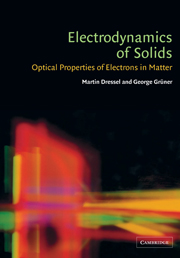Book contents
- Frontmatter
- Contents
- Preface
- 1 Introduction
- PART ONE CONCEPTS AND PROPERTIES
- 2 The interaction of radiation with matter
- 3 General properties of the optical constants
- 4 The medium: correlation and response functions
- 5 Metals
- 6 Semiconductors
- 7 Broken symmetry states of metals
- PART TWO METHODS
- PART THREE EXPERIMENTS
- PART FOUR APPENDICES
- Index
3 - General properties of the optical constants
Published online by Cambridge University Press: 20 May 2010
- Frontmatter
- Contents
- Preface
- 1 Introduction
- PART ONE CONCEPTS AND PROPERTIES
- 2 The interaction of radiation with matter
- 3 General properties of the optical constants
- 4 The medium: correlation and response functions
- 5 Metals
- 6 Semiconductors
- 7 Broken symmetry states of metals
- PART TWO METHODS
- PART THREE EXPERIMENTS
- PART FOUR APPENDICES
- Index
Summary
In Chapter 2 we described the propagation of electromagnetic radiation in free space and in a homogeneous medium, together with the changes in the amplitude and phase of the fields which occur at the interface between two media. Our next objective is to discuss some general properties of what we call the response of the medium to electromagnetic fields, properties which are independent of the particular description of solids; i.e. properties which are valid for basically all materials. The difference between longitudinal and transverse responses will be discussed first, followed by the derivation of the Kramers–Kronig relations and their consequences, the so-called sum rules. These relations and sum rules are derived on general theoretical grounds; they are extremely useful and widely utilized in the analysis of experimental results.
Longitudinal and transverse responses
General considerations
The electric field strength of the propagating electromagnetic radiation can be split into a longitudinal component EL=(nq·E)nq and a transverse component ET=(nq×E)×nq, with E=EL+ET, where nq=q/|q| indicates the unit vector along the direction of propagation q. While EL∥q, the transverse part ET lies in the plane perpendicular to the direction q in which the electromagnetic radiation propagates; it can be further decomposed into two polarizations which are usually chosen to be normal to each other.
Information
- Type
- Chapter
- Information
- Electrodynamics of SolidsOptical Properties of Electrons in Matter, pp. 47 - 70Publisher: Cambridge University PressPrint publication year: 2002
